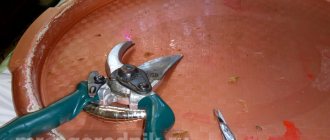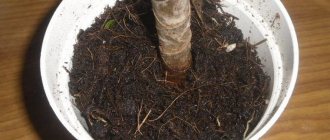Saintpaulia is an ornamental plant that does not require careful care.
In order for an indoor flower to produce buds and flowers abundantly, it must be replanted on time, adhering to all the rules.
Indoor Saintpaulia is replanted once a year in the spring..
During this period, the flower recovers from winter sleep, and all its metabolic processes accelerate.
How to know if it's required
Sometimes it happens that there is still a lot of space in the pot and the grower decides not to replant the plant.
You can find out whether you should replace the pot by the following signs:
- The stem at the bottom is bare . In this case, the lower leaves of the violet dry out and fall off, leaving the base “bare.”
- The soil in the pot is too acidic and no longer contains nutrients.
- A whitish layer of soil appeared on the surface of the earth . This phenomenon means that the earth is oversaturated with mineral fertilizers.
- The lump of earth is entwined with old roots , the earth is practically invisible. To understand how much space is left for roots, you need to lift the flower by the leaves and free it from the pot.
If one or more factors are present, the soil and pot for Saintpaulia need to be urgently replaced.
When is the best time to replant?
The most unfavorable time to transplant violets is winter and summer. At these times of the year, the plant does not take root well, and in the future it loses its decorative properties.
It is better to replant Saintpaulia in spring and autumn with additional lamp lighting . The most favorable time is May.
If the violet variety is special and rare, then it is better to focus on the period of budding and flowering of the flower. The appearance of new shoots and flowers is an indicator of the normal growth of Saintpaulia, which does not need to be replanted.
Experienced flower growers occasionally focus on the position of the Moon relative to the planet. It is recommended to transplant Saintpaulia to the waxing Moon.
Is it possible to replant a flowering Saintpaulia?
We are often asked: is it possible to replant a blooming violet? One of our experts will answer this question for you.
Expert opinion
Klimkina Elena Vladislavovna
Florist, businessman. Organized her business on a country plot of land
First of all, you need to find out for what purpose you want to transplant. Just because the time has come, do you think the pot is too small, etc.? In this case, we would recommend that you wait until after flowering. After all, if a plant blooms, it means it is quite comfortable and in such conditions, no critical or dangerous processes occur.
But if you understand that the flower needs to be saved - for example, the soil in the pot has become sour, pests have infested, or the soil has already become too poor, then you need to act immediately. Even if the violet is blooming at this time.
Yes, it will most likely stop flowering, but at the same time you will save the plant
Transplantation of violets with complete and partial replacement of soil, as well as transshipment of flowering plants
Violets, like any other indoor plants, cannot spend their entire lives in the pot in which you originally planted them. In any case, they will require you to change your “place of residence” to larger apartments. And there is an obvious reason for this: the violet grows and it simply becomes crowded. And if you do not know how to transplant a violet and do not complete this process on time, then the plant will no longer please you with its picturesque flowering and, moreover, will begin to rapidly wither. And to prevent this, plants must be replanted annually.
By transplanting violets in a timely manner, you contribute not only to lush flowering, but also to their rejuvenation
Do I need to do this after purchase?
After purchasing Saintpaulia, you need to carefully inspect it , removing all dry flowers and rotten, damaged leaves.
Then you need to remove all unopened buds so that the violet can calmly endure the process of adaptation.
In the first few days, you should not water or fertilize the flower - the soil in the pot should dry out . Then the violet requires emergency replanting.
As is correct, flowers for sale are grown and exported in special pots with peat, which has no nutrients.
After transplanting, the violet should be covered with cling film or a thin bag to create greenhouse conditions. After a week and a half it is removed.
The best varieties of violets, their features
It is difficult to choose from the variety of varieties the flower that will suit the conditions of your home or apartment and that will delight you with its unique appearance. Among violets there are many species that are already known and have gained popularity:
| Variety | Description of the flower | Peculiarities |
| Beautiful Creole | Velvety flowers of a dark blue tone are collected on a small rosette of green leaves. A white stripe runs along the edges of the petals. | The variety is unpretentious and blooms for a long time. |
| Marshmallow | Large semi-double petals are distinguished by a white-pink color. The rosette of leaves is compact and lush. | Reaches rapid growth and flowering, requires proper care. |
| Pauline Viardot | The wine shade of the petals is combined with a white border around the edge. The inflorescences are arranged vertically. The leaves are dark green in the middle, whitish at the edges, collected in a compact rosette. | Flowering depends on care. |
| Magenta | The variety has large flowers of double and semi-double type. The color of the buds is red-burgundy with a white border around the edge. The leaves are light green and collected in a small rosette. | The plant must be watered through a tray. |
| Winter smiles | Pink semi-double petals with fringed light green edges. The flowers reach a diameter of 6 centimeters. The leaves are elongated, quilted. | The plant blooms luxuriantly and profusely, and is easy to care for. |
| Ming Dynasty | The violet has cup-shaped petals that are pinkish in color. The leaves are green, variegated, with wavy edges. | One of the unpretentious plants that easily tolerates unfavorable conditions. |
| Chanson | The flower consists of many dark blue petals. Light and dark pink spots are visible on the slightly wavy petals. The large rosette consists of smooth, shiny green leaves. | Blooms lushly and profusely. The variety has a long flowering period. |
The decorative value of Saintpaulia lies not only in the beauty of the buds and the structure of the petals, but also in the leaves. They are also varied in color. Variegated varieties are often found, with wavy edges and a velvety or smooth surface.
Which soil to choose
To successfully transplant Saintpaulia, you need to prepare new soil and a suitable container.
You can buy soil at a specialty store or prepare it yourself.
You can find out how to choose soil for Saintpaulia and whether you can make it yourself from the material at our link.
The second option is preferable in the case of breeding rare varieties of flowers.
To create a universal substrate for violets, you will need turf soil, sand, humus and turf in proportions of 2: 1: 1: 0.5, respectively.
A prerequisite for preparing the mixture is its sterilization. The soil needs to be calcined in the oven for two hours, heated in a water bath, or use another method as desired.
Such soil can be used only on the fourth day.
The result should be soil with a fairly loose and airy structure and a slightly acidic pH. Before planting violets, the soil can be additionally shed with a weak solution of potassium permanganate for disinfection.
Varietal violets, for example “Dance of the Galaxy” and “Chimera”, are especially demanding on the substrate.
Selecting a pot
The new capacity must meet several parameters.
The best option is a plastic pot, which is 2-3 centimeters larger in size than the previous one.
If the container is not new and has been used previously, then it must be cleaned of salt deposits and then treated with a solution of potassium permanganate.
Important! The pot should have holes at the bottom to allow excess water to escape. Drainage made of small stones, fragments of clay or expanded clay is also placed at the bottom.
The root system of violets does not tolerate waterlogging of the soil - the shoots quickly wither and the shoots rot.
Note! Our website has detailed material on how to choose a pot for violets. If you would like more information on this topic, please use our link. We also recently answered in great detail the question about methods of propagating violets and talked about the spectacular terry Saintpaulia “Amadeus”.
Transplant methods
Violets can be replanted using several methods - complete or partial replacement of soil, transshipment. Each of them has its own advantages and disadvantages, which allows them to be used in different situations.
Transshipment
The transshipment method is better suited if the flower has a fragile or unformed root system.
It must be used when new shoots have taken root after planting and then suddenly begin to wither.
To replant, Saintpaulia is removed from the pot along with the soil on the roots..
The gardener's task is to prepare a new pot with a larger diameter. The flower is placed in a new container so that the height of the new and old soil is at the same level.
The voids below and on the sides are filled with new soil.
Partial soil replacement
The partial soil replacement method is often used for replanting mini-cultivars. It involves removing the top layer of soil from the pot and adding a new layer. In this case, the pot may remain the same.
Complete soil replacement
Before completely replacing the earthen ball, it is necessary to moisten the soil in the pot using a spray bottle.
After this, the violet is pulled out by the rosette and its roots are washed under running water, getting rid of excess soil.
The plant should be left on a paper towel for a few minutes to allow the roots to dry naturally.
Please note that before planting in a new pot, the root system must be carefully inspected and, if necessary, rotten and dead areas of roots must be removed.
The broken or cut areas are sprinkled with crushed activated carbon for disinfection.
Reproduction by daughter rosettes
A daughter rosette is a young offspring formed from a planted leaf cutting. Often the leaves delight owners with several rosettes at once; this is more likely when rooting in water, especially if the leaves are not planted before the babies appear.
Some time after planting the leaf, young offspring appear.
All children formed on the sheet can be used for reproduction
It is important to allow the rosettes to grow together to an acceptable size for replanting.
Children are separated if each has:
- Minimum of two leaves;
- Own growth point;
- And also at least 3-5 roots.
The division is carried out very carefully; if they have grown together strongly, they are cut:
- With a sharp knife;
- Or a blade.
Next, each plot is given its own pot and planted in the ground.
Advice! Children from one sheet should be designated not only by the name of the variety. If the baby does not exactly repeat the flowering of the mother (when chimeras reproduce, the chance of repetition is 20-30%), then those formed from the same leaf will be the same.
Step-by-step instructions for transplanting at home
When replanting, you need to prepare a new container for the flower, a universal soil mixture that is suitable for perennial ornamental plants, and the flower itself.
A week before replanting, you need to reduce watering the violet so that the roots can dry out a little.
Step-by-step instructions for replanting Saintpaulia:
- moisten the soil with a spray bottle so that it does not stain your hands during the procedure;
- remove all excess soil from the violet roots, remove rotten areas;
- rinse the roots under running tap water and leave to dry on a paper towel;
- put a drainage layer at the bottom of the new pot - vermiculite, stones, clay shards;
- sprinkle the drainage with a small amount of soil mixture and then install the violet on it;
- place the Saintpaulia and carefully fill all the free space in the pot with soil, sprinkling it in small portions;
- a layer of earth is poured up to the beginning of the rosette , leaving it and part of the rhizome on the surface;
Do you collect violets? Then we recommend that you pay attention to very spectacular varieties that do not require special care - “Raisin”, “Duchess”, “Wedding Bouquet” and “Royal Lace”.
Soil requirements
The soil substrate for Saintpaulia is either store-bought or prepared with your own hands. The main thing is that it is loose, well permeable to air and water:
- The mixture should contain leaf soil, turf, peat or humus.
- To make the substrate loose and light, you need coarse sand and charcoal.
- You can add vermiculite, which makes the soil more permeable.
To prevent the plant from becoming infected with a fungus, the soil is disinfected. To do this, use watering with a pink solution of potassium permanganate or calcination in the oven. Disinfect the soil 2 weeks before transplanting. You can replace the soil in the container partially or completely.
Post-procedure care
After replanting, you need to make sure that the violet does not tilt on its side and is held firmly in the pot. Only after this can further care for the flower be carried out.
Proper watering
Since the earthen ball was moistened during transplantation, and the new soil is saturated with useful substances, the violet in the new place does not need watering so badly.
If the soil in which you planted the plant was slightly damp, it is better to postpone watering for one day. And if the soil was dry, then you can water it a little, but there should be literally 2 teaspoons of water.
Read more about how to properly water violets in the material at this link.
Possible mistakes
When replanting, inexperienced gardeners may make minor mistakes, which then slow down the growth of the flower or lead to its death.
These include:
- damage to the root system;
- excessive watering, which entails rotting of the roots;
- use of heavy soil;
- lack of drainage in the pot.
In case of excessive root pruning, a special preparation that is sold in a flower shop can correct the situation . Kornevin is used to stimulate the growth of new roots and the active growth of the flower itself.
If other mistakes are made, the violet must be urgently replanted, adhering to all the rules.
The rules for replanting violets can be changed for each individual case, because there are certain varieties of Saintpaulia that require special treatment. These include mini-versions and rare varieties.
If you care for your plants correctly and your violets are not blooming, we recommend that you familiarize yourself with the most common causes of this problem. This may be caused by diseases, pests or some other reasons.
Leaf propagation
Planting methods differ depending on the method of rooting the violet cuttings.
In water
For rooting in water, a leaf is selected without damage from the middle tier, and in no case from the lower one. Cut carefully with a sharp knife, being careful not to damage other leaves. The cuttings are left no more than 3-4 cm in length.
As quickly as possible, the cut leaf is placed in an opaque container with settled water. The cut is immersed in water by 1.5-2 cm; it should not touch the walls of the vessel. To do this, the sheet is secured with paper or a plastic cover.
Rooting in water.
After 2-4 weeks, roots begin to appear. The leaf is ready for planting when the roots reach 2 cm in length. Take a small pot and fill it one-third with drainage. The soil is prepared in the same way as for adult plants.
In the ground
Quite often, novice gardeners are concerned with the question of whether it is possible to plant a violet without roots. It is possible, and this method is even preferable because the leaf takes root quite quickly, and the new plant develops faster.
The leaf is cut in the same way as in the first case, buried in the prepared slightly moist soil by 0.5 cm and the soil is gently pressed around the cutting. Then the container with the sheet is covered or placed in a plastic bag. This mini-greenhouse will allow you to maintain optimal temperature and humidity.
Rooting in the ground.
After a new rosette of leaves appears, the planting leaf can be cut off.
Advice! To grow violets from leaf cuttings, it is very convenient to use peat tablets. The dry tablet is placed in a container and filled with water.
The cutting is carefully immersed in the swollen, moist substrate using a sharp wooden stick.











